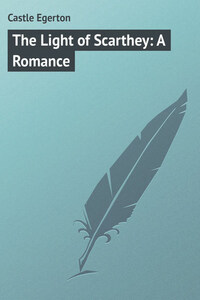CHAPTER I
THE PEEL OF SCARTHEY
He makes a solitude and calls it peace.
Byron.
Alone in the south and seaward corner of the great bight on the Lancastrian coast – mournfully alone some say, gloriously alone to my thinking – rises in singular unexpected fashion the islet of Scarthey; a green oasis secure on its white rocky seat amidst the breezy wilderness of sands and waters.
There is, in truth, more sand than water at most times round Scarthey. For miles northward the wet strand stretches its silent expanse, tawny at first, then merging into silver grey as in the dim distance it meets the shallow advance of briny ripple. Wet sand, brown and dull, with here and there a brighter trail as of some undecided river seeking an aimless way, spreads westward, deep inland, until stopped in a jagged line by bluffs that spring up abruptly in successions of white rocky steps and green terraces.
Turn you seaward, at low tide there lies sand again and shingle (albeit but a narrow beach, for here a depth of water sinks rapidly) laved with relentless obstinacy by long, furling, growling rollers that are grey at their sluggish base and emerald-lighted at their curvetting crest. Sand yet again to the south, towards the nearer coast line, for a mile or perhaps less, dotted, along an irregular path, with grey rocks that look as though the advance guard of a giant army had attempted to ford its insecure footing, had sunk into its treacherous shifting pits, and left their blanching skull-tops half emerging to record the disaster.
On the land side of the bight, far away beyond the grandly desolate, silent, yellow tract, a misty blue fringe on the horizon heralds the presence of the North Country; whilst beyond the nearer beach a sprinkling of greenly ensconced homesteads cluster round some peaceful and paternal looking church tower. Near the salty shore a fishing village scatters its greystone cabins along the first terrace of the bluffs.
Outwards, ever changing in colour and temper roll and fret the grey waters of the Irish Sea, turbulent at times, but generally lenient enough to the brown-sailed ketches that break the regular sweep of the western horizon as they toil at the perpetual harvest of the deep.
Thus stands Scarthey. Although appearing as an island on the charts, at low tides it becomes accessible dry-foot from the land by a narrow causeway along the line of the white shallow reefs, which connect the main pile to the rocky steps and terraces of the coast. But woe betide man or beast that diverges many feet from the one secure path! The sands of the great bay have already but too well earned their sinister reputation.
During the greater part of the day, however, Scarthey justifies its name – Skard- or Scarth-ey, the Knoll Island in the language of the old Scandinavian masters of the land.
In fair weather, or in foul, whether rising out of sunny sands when the ebbing waters have retired, or assailed on all sides by ramping breakers, Scarthey in its isolation, with its well-preserved ruins and its turret, from which for the last hundred years a light has been burning to warn the seafarer, has a comfortable look of security and privacy.
The low thick wall which in warlike times encompassed the bailey (now surrounding and sheltering a wide paddock and neat kitchen gardens) almost disappears under a growth of stunted, but sturdy trees; dwarf alders and squat firs that shake their white-backed leaves, and swing their needle clusters, merrily if the breeze is mild, obstinately if the gale is rousing and seem to proclaim: "Here are we, well and secure. Ruffle and toss, and lash, O winds, the faithless waters, we shall ever cling to this hospitable footing, the only kindly soil amid this dreariness; here you once wafted our seed; here shall we live and perpetuate our life."
On the sea front of the bailey walls rise, sheer from the steep rock, the main body and the keep of the Peel. They are ruinous and shorn of their whilom great height, humbled more by the wilful destruction of man than by the decay of time.
But although from a distance the castle on the green island seems utterly dismantled, it is not, even now, all ruin. And, at the time when Sir Adrian Landale, of Pulwick, eighth baronet, adopted it as his residence, it was far from being such.
True, the greater portion of that mediæval building, half monastic, half military, exposed even then to the searching winds many bare and roofless chambers; broken vaults filled with driven sands; more than one spiral stair with hanging steps leading into space. But the massive square keep had been substantially restored. Although roofless its upper platform was as firm as when it was first built; and in a corner, solidly ensconced, rose the more modern turret that sheltered the honest warning light.
The wide chambers of the two remaining floors, which in old warlike days were maintained bare and free, and lighted only by narrow watching loopholes on all sides, had been, for purposes of peaceful tenanncy, divided into sundry small apartments. New windows had been pierced into the enormous thickness of stone and cement; the bare coldness of walls was also hidden under more home-like panellings. Close-fitting casements and solid doors insured peace within; the wind in stormy hours might moan or rage outside this rocky pile, might hiss and shriek and tear its wings among the jagged ruins, bellow and thunder in and out of opened vaults, but it might not rattle a window of the modern castellan's quarters or shake a latch of his chamber door.








